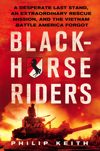 Blackhorse Riders: A Desperate Last Stand, An Extraordinary Rescue Mission, and the Vietnam Battle That America Forgot, by Philip Keith, St. Martin’s Press, 2011
Blackhorse Riders: A Desperate Last Stand, An Extraordinary Rescue Mission, and the Vietnam Battle That America Forgot, by Philip Keith, St. Martin’s Press, 2011
The 11th Armored Cavalry Regiment, better known by its distinctive insignia-borne nickname, the Blackhorse Regiment, started as a horse cavalry outfit in 1901. The regiment went mechanized in World War II, and when the Blackhorse troopers moved into Vietnam in September 1966, its three squadrons had more than 50 tanks, nearly 300 armored personnel carriers (APCs), 18 155mm howitzers and nine flamethrower vehicles.
Some thought that a heavily armored unit would be of little use in Vietnam. They were wrong. The Blackhorse Regiment fought effectively for four years in Vietnam, taking part in many large and small engagements, including the 1968 Tet Offensive and the Cambodian incursion in 1970.
Before the May 1 move into Cambodia—on March 26, 1970—the regiment’s Alpha Troop, 1st Squadron, battled through a vicious but never-named all-day struggle in triple-canopy jungle along the border. In that fight, the 200-odd men of Alpha Troop rescued an understrength and under-siege 1st Cavalry Division unit—C Company, 2nd Battalion, 8th Cavalry—that had inadvertently bumped into a huge hidden NVA stronghold. The 80 men of Charlie Company soon were fighting for their lives, surrounded by some 400 NVA.
Alpha Troop’s commanding officer, Captain John Poindexter, heard Charlie Company’s frantic pleas for help over the net when his unit was hunkered down in a night defensive position not far from Charlie’s position. Poindexter never received orders to try to rescue the neighboring company; he acted on his own, ordering his men to saddle up and move out.
“Rescue seemed impossible,” Philip Keith writes in Blackhorse Riders, his well-crafted account of the engagement. “Helicopters could not penetrate the dense jungle to land, drop supplies, or extract the men. Artillery and air support could not be targeted effectively without the possibility of killing friendlies as well as the enemy. It seemed the company [Charlie] was fated to be worn down, outgunned, and eventually all killed or captured.”
Alpha Troop did not allow that doomsday scenario to come to pass. The Blackhorse men and their 19 combat vehicles barged through four kilometers of heavy jungle and joined the fray with the exhausted Charlie Company infantrymen. A solid eight hours of combat ensued. The American troops prevailed; Charlie Company was rescued.
Keith, a U.S. Navy aviator in Vietnam, tells the dramatic story of Alpha Troop’s daring, dangerous and successful mission very effectively in Blackhorse Riders—told primarily through the eyes of the men who took part in it. Keith, in fact, calls himself the “narrator” of this tale. But he does much more than that. Keith interviewed dozens of survivors from Alpha Troop and Charlie Company. He also combed through the official records. The result is an overdue tribute to the men of Alpha Troop.
Keith also tells a corollary story of how the unit fought for years to be recognized for the courage of its men under fire on March 26, 1970. That effort came to fruition on October 20, 2009, when 119 men of Alpha Troop went to Washington, D.C., and received the Presidential Unit Citation in a solemn ceremony in the White House Rose Garden.
“As these men will tell you themselves, this isn’t the story of a battle that changed the course of the war,” President Barack Obama said in his remarks that day. “It never had a name, like Tet or Hue or Khe Sanh. It never made the papers back home. But like countless battles, known and unknown, it is a proud chapter in the story of the American soldier.”
—Marc Leepson




